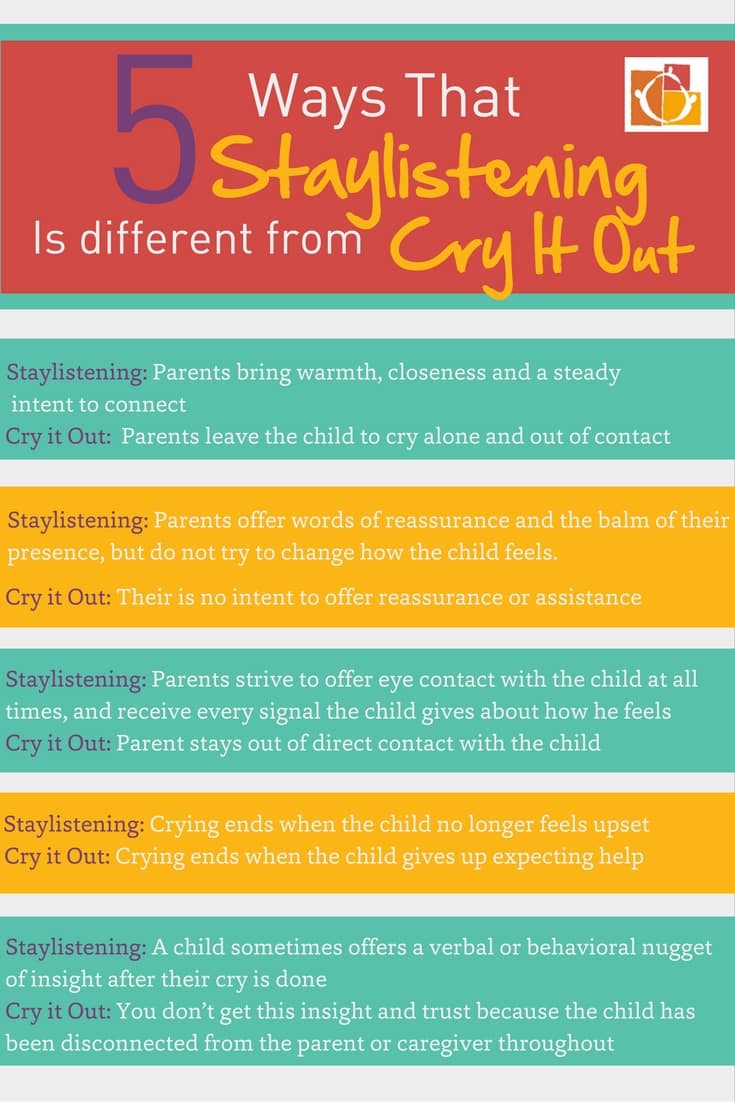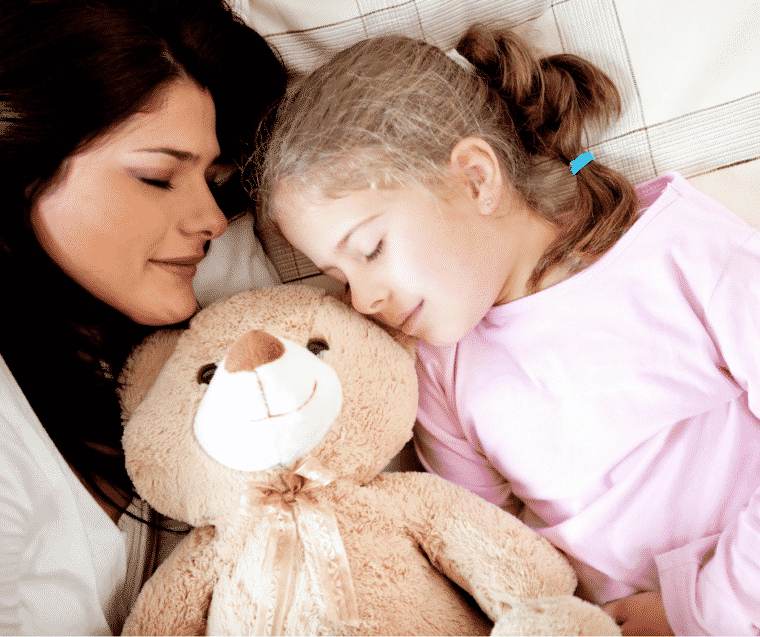Often, our children find reason to be beside themselves with upset. These are rough times for them, and trying times for us as parents, too. We are taught to hush, shush, distract, rock, jiggle, joke, or, when we hit that l ow point on the patience meter, to scold or punish. But there’s a new and elegant tool for handling your child’s upsets that departs from the shushing → frustration → burst of anger route!
ow point on the patience meter, to scold or punish. But there’s a new and elegant tool for handling your child’s upsets that departs from the shushing → frustration → burst of anger route!
Before you get to the end of your rope one day, experiment with Staylistening. This approach does advocate crying, but it does not mean sending a child off to cry it out.
How Does Staylistening Help?
When your child bursts into tears or a tantrum, hold that sensible limit–“No, only one cracker, my love”–if that’s what started him off. Say little, but stay close and listen warmly as your child has a big cry.
Staylistening is a deeply healing act when you can manage to be relaxed and simply accept your child’s need to cry or tantrum or storm. Listen to your child and don’t try to stop the big feelings that are passing through him. Now and then, mention the issue that first upset him, for example, “Yes, the corner broke off your cracker,” then give him a brief reassurance that you will keep him safe.
Staylistening employs the insight that crying, tantrums, and vigorous, stormy protest are the instinctive ways that our children offload emotional tension and heal from feelings of hurt. Staylistening helps to melt feelings of helplessness, frustration, fear, and many other kinds of upset. Over several decades, I’ve seen that when a parent or caregiver can be a warm emotional anchor as their child dives deep into feelings, the child emerges feeling close to their parent or caregiver, and relieved of his concerns–even if his cracker is still missing its corner.
For example, I know one school-aged boy who could not eat candy for medical reasons. He had a long, passionate cry on Halloween afternoon. It felt like the height of unfairness that he couldn’t even taste the candy that would soon be in his bag!
His mother Staylistened through his whole outburst, letting him know that she saw this was hard for him, and that she cared. Afterward, he was elated to go trick-or-treating. He wasn’t tempted to eat his candy, and gave it all to her without a peep when the night was over.
Why Should Parents Let
Their Children Cry?
We don’t know exactly why Staylistening has this healing power. We do know that when you hold a relaxed, positive, respectful attitude, you give rich nonverbal messages via your body language, tone of voice, and facial expression, and when you exude positive regard and quiet confidence that all will soon be well, your child receives that message, in spite of the fact that he is experiencing powerful negative feelings. He continues to offload that emotion, and seems carried away by it. But he is simultaneously recording the “All is well—you are not alone with this” message that you or other kind adult offer him.
That message seems to sink ever deeper into a child’s consciousness as he cries, has tantrums, or storms and protests.
- Your child may feel scared, but you show him your caring, not fear.
- He may feel deprived, but you offer him a bounty of warmth and attention.
- He may feel angry, but you come to understand that this is how he gets rid of his anger, so you take no offense.
- He may feel unable to handle an impending separation, but you remain sure that he is safe now, and will be safe with your chosen caregiver.
- If it’s the caregiver who is Staylistening, they reassure your child that you will return. They offer their warmth, which is the very best substitute for your caring at that moment.
And as soon as your child has released the feelings that flooded his system, he can think again, and the impression of safety made by your relaxed, warm presence falls into place.
Your child feels connected – because you have poured in connection.
Your child feels safe – because you have shown confidence that all is essentially well.
Your child feels capable – because you have treated his outburst as a normal, useful recovery process.
You respected his natural instinct to heal from hurt with crying, a tantrum, or stormy, sweaty protest.
You, or perhaps another kind listener, accompanied him through his emotional moments, and your child discovers that he is safe after all.
How is Staylistening Different from Cry it Out?
Staylistening is the opposite of “Cry-it-Out,” in these five important ways:
1) With Staylistening, the parent brings warmth, closeness, and a steady intent to connect with their child. The parent acts as a healing agent, radiating safety while the child feels unsafe.
In Cry-it-Out, the parent leaves the child to cry alone and out of contact, adding new fears to the issue he was unhappy about in the first place.
2) With Staylistening, the parent offers some words of reassurance and the balm of their presence, but does not try to change how the child feels.
With Cry-it-Out, the intent is to offer no reassurance or assistance, in order to discourage the child from crying or calling out for help.
3) With Staylistening, the parent strives to offer eye contact with the child at all times, and receives every signal the child gives about how he feels.
With Cry-it-Out, the parent stays out of direct contact with the child, and does not receive the child’s detailed signals about how he is feeling.
4) With Staylistening, the crying ends when the child no longer feels upset.
With Cry-it-Out, the crying ends when the child gives up expecting help and a loving response.
5) With Staylistening, the child sometimes offers a verbal or behavioral nugget of insight after their cry is done. “Mommy needs to rest,” says a child who has cried because Daddy did the bedtime routine. “Whew, there was a lot in there!” says a toddler whose father listened to him through a long, hard cry for the first time. A formerly frightened child leans relaxedly into his caregiver after the caregiver Staylistens to him cry frantically about wanting his Mommy or Daddy.
With “Cry it Out,” you don’t often get these gems of insight and signs of trust, because the child has been disconnected from the parent or caregiver throughout.
Does Staylistening Always Work?
 When the hurt your child feels is one that goes deep, it can take a number of Staylistening cries before he gains confidence in a challenging situation. But there are usually small signs of progress time by time, and the act of listening to foster healing can be deeply rewarding in itself.
When the hurt your child feels is one that goes deep, it can take a number of Staylistening cries before he gains confidence in a challenging situation. But there are usually small signs of progress time by time, and the act of listening to foster healing can be deeply rewarding in itself.
Staylistening relieves us of the thankless job of trying to fix what is essentially unfixable. We can’t magically erase the feelings that overtake our children.
What we can do is to listen, care, expect the best, and enjoy the recovery we foster in our children, at whatever pace it comes.
How Staylistening Resolves Parenting Challenges
Here is a real-life situation where a mother I know saw the difference Staylistening brought to a challenging situation:
“When my daughter was around two, I was ready for her to move to her own bed. I knew helping children sleep in their own beds could be challenging, and I wanted the transition to be as easy as possible for her, so I thought naptime, instead of bedtime, would be the best way to slowly introduce this idea.
 However, when I told her she would be napping in her bed, instead of in mommy and daddy’s bed, she began crying, yelling and fighting the idea. This was not what I was expecting.
However, when I told her she would be napping in her bed, instead of in mommy and daddy’s bed, she began crying, yelling and fighting the idea. This was not what I was expecting.
I gently told her that I would stay and nap with her. This didn’t ease her fears and her crying intensified.
I was still pretty new to Staylistening at the time and began to have doubts about transitioning her to her own bed because her reaction was so intense. I had to remind myself it was a safe situation, we were only napping in a different bed.
I also reminded myself that she never had a problem sleeping in other beds, like at a relative’s house or in a hotel while traveling, so whatever her feeling was, it wasn’t about the current situation. It seemed the feeling was some deeper fear that needed to come out before she would feel okay in her own bed, whether it was day or night.
I listened as she cried and fought and yelled, saying “I can’t and won’t sleep in my own bed.”
I offered gentle reassurance that I really thought it was okay to nap in her bed and reminded her that I would stay with her. We stayed on the bed together while she showed me how hard it was to even think about this change.
Then, when she tired of crying she fell asleep in her bed.
This pattern repeated for the next two days. I’d tell her we were going to nap in her bed and then she’d scream and cry that she couldn’t do it while I kept holding out the idea that her bed was a good place to sleep.
On the fourth day? Success! She napped in her own bed like it had never been a problem.
After such hard work on both our parts–she showing me how hard it was to make the change and me listening and creating a safe space for her to release her fears—I decided to hold off on the nighttime transition for awhile.
But my daughter had other plans. Exactly a week later, at bedtime, she said she wanted to start sleeping in her own bed at night too. And she did! It was tough listening those three days, but so worth it for both of us. And I’m so glad she was able to initiate the nighttime transition when she was ready.”
Can You Staylisten with Babies?

Infants, too, sometimes carry emotional tension that is better listened to than held in with pacifiers, jiggling, walking, and other distractions. Many, if not most infants go on a crying jag almost daily in spite of the comforts their parents offer–It may be that it’s not all that easy being born and being an infant, with surprising things happening all day long, and so much to comprehend.
There’s much to say on this subject, but briefly, when your baby cries I recommend going to her immediately, and running through your hunger/temperature/diaper status/pain checklist.
Try the caregiving measures you think might help. But if none of them seem to return her to contentment, you could try settling in and listening to her for a while, murmuring reassurances now and then, to see if your confident acceptance of her feelings gradually relieves her mind.
You could also try offering your baby dedicated listening time when she’s just been fed, but is still alert. If your warm, appreciative attention is soon met with crying, it could be that she’s decided to “tell you” about some hard times she’s had. Your warm, generous attention may have signaled her that now is the time to show you how difficult things were.
Her crying may end with her falling into a deep sleep, or engaging in a long, relaxed, aware mutual gaze that lets you know that you’ve helped her feel safe, cared for, and content once again.
Would you like to confidently help your child sleep through the night? Enroll in our Helping your Children Sleep class.
Find out What to Say During Staylistening
Get our free guide to Hand in Hand's five revolutionary listening tools that make parenting less stressful
Patty Wipfler is the author of Listen: Five Simple Tools To Meet Your Everyday Parenting Challenges. Read a chapter here.

